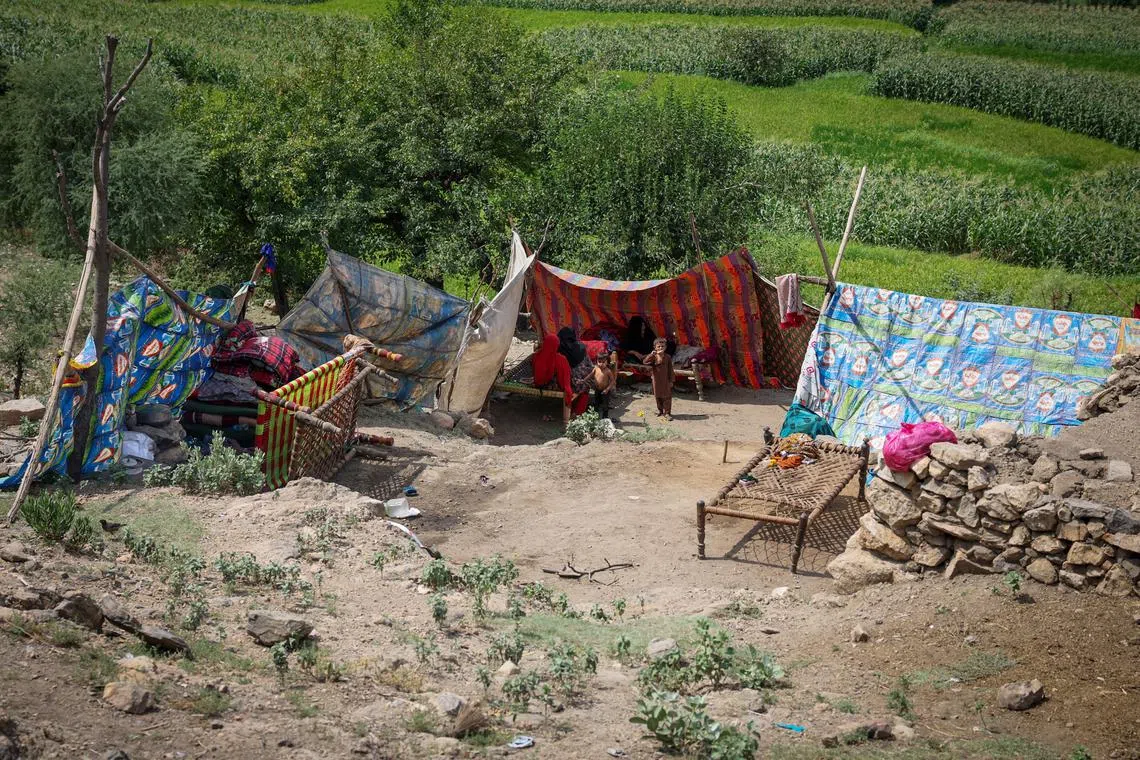Afghan quake survivors search for loved ones, pull planks from rubble for graves
Sign up now: Get ST's newsletters delivered to your inbox

An Afghan family sitting inside a makeshift shelter at Lulam village, in Nurgal district, Kunar province, Afghanistan, on Sept 3. A deadly 6-magnitude quake struck the country on Aug 31, destroying thousands of homes.
PHOTO: REUTERS
Follow topic:
MAZAR DARA, Afghanistan – Mr Mir Salam Khan mourns the loss of his wife and three children in Afghanistan’s mountainous eastern province of Kunar, which was hit by a 6-magnitude earthquake, destroying thousands of homes.
“We buried them with wooden planks and plastic sheets, so the soil would not fall directly on the bodies,” said the 65-year-old resident of Mazar Dara village. “That was all we could do.”
The shallow midnight tremor on Aug 31, Afghanistan’s deadliest quake in years, killed more than 2,200 people and destroyed over 5,000 houses, officials of the Taliban administration have said.
But harsh weather and rugged terrain have hampered rescue work.
Here, the dead are usually wrapped in shrouds and placed in graves topped with cement slabs.
With supplies scarce and many homes destroyed, however, survivors said that they were forced to improvise with wood and plastic picked out of the wreckage.
“We have never witnessed such an earthquake in history,” said Mr Yunus Khan, 45, who was seated amid the rubble of his mud-brick home that trapped two of his children, while three more were among the 12 of his family who died.
“All belongings were lost, the children were martyred,” he added, as he was surrounded by homes with crumbling walls, their wooden beams sticking out of rubble where children sat silently.
“It was such a quake that it gave no one a chance,” Mr Yunus said. “With one jolt, the entire village was destroyed.”
Most survivors remain stranded among the ruins, burying their dead in graveyards filling with freshly dug plots for children and adults.
Aid workers are just reaching the remote hamlets. A single tent, shared by half a dozen families, sagged in the rain as helicopters circled overhead to ferry the wounded to hospital.
“Last night it rained, and we had no shelter,” Mr Yunus said. “Five or six families are in one tent, there are no supplies. Even the bodies lay out in the rain, waiting to be buried.”
Farmer and livestock owner Namirullah, 30, joined about 50 neighbours in digging through rubble with their bare hands.
“The martyrs are still trapped and the injured are so many,” said the volunteer from the nearby village of Chapa Dara.
“People have abandoned their homes and are living in cornfields and orchards, terrified as aftershocks come every few minutes,” he said.
The Defence Ministry said the Afghan Air Force moved more than 1,900 people in 155 flights over two days, including hundreds of wounded among them, and delivered 10,000kg of supplies across the region.
Hemmed in by mountains where the Indian and Eurasian tectonic plates meet, Afghanistan is no stranger to such devastation.
A quake in 2022 killed about 1,000 people, and successive shocks in 2023 flattened villages in Herat.
Four smaller tremors rattled the country in 2025.
Each new disaster strikes a nation crippled by poverty, war and shrinking aid, with the UN estimating that half the population of more than 40 million needed assistance even before the most recent quake.
Two days later, Mr Salam was still waiting for the bodies of his son and daughter to be pulled from the ruins of his home. He and his neighbours used shovels and their hands in an effort made painfully slow without earthmoving machinery.
“Two of my children are still under the rubble,” he said. “We can do nothing.” REUTERS

